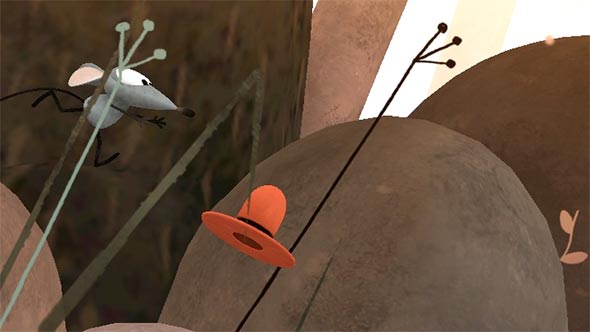Spotlight Stories Platform Aims to Develop New Narrative Forms for the Smartphone
Owners of Motorola's Moto X Android-powered smartphones had a surprise last week, when a little red hat appeared on their home screen. That hat functioned as the start button for something completely new — an animated story where the virtual camera is held and controlled by the viewer. When you tap the hat, it starts moving around the screen as if held aloft by a breeze, against a forest backdrop. In order to keep the hat in frame, you move your phone around in front of you, following it through the virtual environment until it settles on the ground and is picked up by a cartoon mouse. From there, the story takes flight again as the mouse chases the windblown hat as various other woodland creatures enter and exit the frame.
Since it's hard to describe, you can get a good sense for the experience by watching this YouTube video from user Phandroid, who recorded the short from beginning to end through Google Glass. (You can get a better look at the images in this reel posted to Vimeo by Daniel Paul, one of the animators who worked on the project.)
Titled "Windy Day," the unique animated short is the first production from Spotlight Stories, a platform Motorola describes as a "creative canvas for storytellers." Developed inside Motorola's Advanced Technology and Projects (ATAP) division, which is led by former DARPA head Regina Dugan, the platform is meant to showcase the graphics horsepower built into the Moto X, with its high-end Qualcomm Adreno 320 GPU. "At a high level, we think about this as a free gift to our users," Baback Elmieh, technical program lead at Motorola ATAP, told StudioDaily. "There is no revenue model behind it."
It's a kind of gift, too, for high-level creatives, who faced a novel set of challenges and opportunities. Motorola recruited director Jan Pinkava (Ratatouille), who brought a slate of Pixar veterans on board, beginning a little more than a year ago with producer Karen Dufilho, who had first worked with him on his Oscar-winning short "Geri's Game," and animator Doug Sweetland, who had directed "Presto" at Pixar and served as story lead, layout artist, and editor on "Windy Day."
"As an animator, you're on the back end of production, and I had longed to work in a more conceptual way," Sweetland said. "There was a feeling that we might very well be working on something that's the first of its kind, which to me was completely electrifying. We were all applying a ton of animation experience to something that was related, but completely new."
Animator Mark Oftedal came on board next, and helped figure out the narrative direction the team would take. "It wasn't a complete blank slate," he recalled. "They had figured out they were going to give the audience a camera to use to look around [a virtual world]. And something was going to happen in that world, but we didn't know what it was going to be. Jan may have had the idea that it should be a forest — a forest is where stories happen. And we thought that was a good starting point: let's see what's going on in the forest."
The creative team was insulated from the technical details of the platform. Using Maya, the animators were able to focus on story and performance just as closely as they would on a feature film; their changes would be executed for the platform and come back quickly for review. "We would marvel at the speed of [Elmieh's] team, said Dufilho. "The turnaround, and their willingness, was so fantastic. It gave Doug and Jan and Mark instant feedback."
Elmieh said the idea was to keep Pankava's group working in as familiar and comfortable an environment as possible, similar to feature animation. "We have our own rendering environment, specific to our device, that taps into the graphics performance of the [Adreno 320] chip," said Elmieh. "We've incorporated technology from Pixar called OpenSubdiv, which is part of RenderMan, so we used the same techniques for animation that you'd use in a feature film. But the rendering is a little different because it's in real time. Every single frame you see is being rendered on the fly, based on where you're looking. We adapted a piece of technology from the space program that lets us do really smooth simulation of a handheld camera. But all that stuff was abstracted away from Jan and the team."
Even for veterans of CG animation, the challenges of "Windy City" were new. "As a filmmaker, you're used to composing your scenes," Dufilho said. "Jan was used to composing a frame, one at a time. Now you've taken that all away."
"You're throwing cinematography out the window," said Sweetland. "What we've made is definitely not a videogame, but it has a little bit of videogame DNA in it, in that it is a long, continuous camera move with no cuts. That's either a limitation or a possiblity. On the one hand, you don't have the control of cutting, but on the other hand you have a much more immersive feel, with events playing out in real time in front of your eyes."

Motorola is hoping to turn the Spotlight Stories platform into a kind of hothouse for creative pioneers that will put a spotlight on the power and innovation of its own devices. "We've found an untapped passion for this kind of exploration," Elmieh said. "Every single director we've talked to has ideas where they're trying to push the boundaries, but there is no way to do it in the traditional model. We offer that. We're excited to have a space where we don't have the same kind of studio system. There are no studio notes. We don't do any of that. We want people to come here and explore their art form — explore storytelling and how people think about that in this modern century."
Two more projects will be announced soon, including a hand-animated 2D short, which Elmieh said presents new challenges on the technical side of the equation. "We're also trying to see what it would mean for live action," he said.
Ducelo, Sweetland and Oftedal all say they appreciated the novel creative exercise. "It's a different kind of storytelling," Oftedal said. "It's more like street theater. You can watch it, or you can just look somewhere else. So what does that do to your sense of timing, and your ability to play up gags and use music? That was the really cool, invigorating stuff to figure out."
"I liken it to a train ride," said Sweetland. "You're going from New York to Los Angeles, and filmmakers so far have decided exactly what route you're going to take. They control all of the images you're going to see. Here, you get to choose your own route. It's not going to be choose-your-own-adventure. You're not going to affect the ending. But you can choose the north route or the south route. You can converge with the main narrative or diverge from it. As more of these are made, I expect we'll see how multiple narratives can be interwoven in a real-time scenario, and that's uncharted territory."
Crafts: VFX/Animation
Sections: Creativity
Topics: Project/Case study augmented reality Doug Sweetland jan pinkava karen dufilho mark oftedal moto x Motorola spotlight stories windy day
Did you enjoy this article? Sign up to receive the StudioDaily Fix eletter containing the latest stories, including news, videos, interviews, reviews and more.











mind blowing